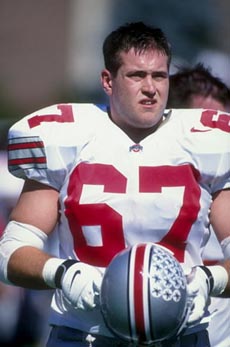 Joe Germaine: Our Favorite Mormon
Joe Germaine: Our Favorite MormonLast week we took an introductory look at the 1998 Buckeye football team. Today, we'll take a closer look at the offense on that team and examine how Boeckman, Beanie and Robo stack up to that explosive unit.
The only word that comes to mind when describing Mike Jacobs' 1998 offense is freaktacular. During their 11-1 march to a #2 ranking, the offense averaged 497.6 yards of total offense, cracking the 500-yard mark eight times on the season, topped by a 627 yard effort against Iowa. To put that into perspective, the 2006 offense, the 2nd-most prolific offense during the past decade, was only good for 384.5 yards-per-game. In fact, Troy, Ted & Co. managed to break 500 yards just twice: against Indiana, and most satisfyingly, Michigan. Both of those marks from 1998 are still school records.
Six different running backs and six different receivers scored touchdowns in an offense that struck fast and often. 26 touchdown drives took two minutes or less and the unit produced 14 touchdowns of 30 yards or longer. On the year, they averaged 35.83 points-per-game and they loved jumping out to early leads -- averaging 22.58 first half points for the season.
They blew past a pretty talented Mountaineer team (Bulger, Jerry Porter, Zereoue, etc.) in the season opener, hung 35 on a ranked Missouri squad, dropped #7 Penn State 28-9 and capped the season by handing the defending national champions a 31-16 defeat. That game is fondly remembered as the time Joe Germaine outplayed Tom Brady.
Backs
The star of the 1998 backfield was undoubtedly Germaine. He capped his final season in Columbus by earning team and conference MVP honors after throwing for a (still) school record 3,330 yards to go along with 25 touchdowns against only seven interceptions. The quiet Rose Bowl hero bounced back from the hammering he took at the hands of Florida State in the 1998 Sugar Bowl to put up 7 games of 300 yards or more, including a mid-season stretch of four in a row. He spread the ball to everyone on the field and he's the last known Buckeye signal-caller to utilize the tight-end. To this day, he's the best pure thrower in Buckeye history.
| QB | Joe Germaine, SR5 |
|---|---|
| RB | Michael Wiley, JR |
| RB | Joe Montgomery, SR |
| FB | Matt Keller, JR |
While it may be easy to think of Michael Wiley as a pedestrian back, especially considering the super-human being the Buckeyes currently have in the backfield, the truth is he was more than pedestrian, especially during his junior season of 1998. His 1,235 yards that season is still good enough for 15th place in the books and he delivered when the team most needed him: 140 against West Virginia, 209 against Missouri, 120 and a 53 yard touchdown against the Wolverines. Hell, he even cracked the century mark in the loss to Michigan State, so you can't accuse him of disappearing there. The 1998 offense, with its pass-first tendencies, was the perfect setup for a back like Wiley. He's no Beanie, and he's not quite Pittman-caliber, but he's definitely worth about three of Lydell Ross:
Wiley was backed up by Joe Montgomery, a guy many fans thought should have been starting as the season progressed. Injuries kept the fire-hydrant of a back out of the mix until his senior season where he was relegated to spot duty. Still, his 766 yards on a 6.5 average speak to his talent. His 80 yard touchdown run on the Buckeyes' first play of the Iowa game set the tone for the beat-down.
Junior Matt Keller was the starting fullback and after making the transition from star running back at Moeller to blocking for others at Ohio State, he emerged as a receiving threat out of the backfield. After starting the season with only one reception in the first four games, Keller stepped it up and finished with at least one reception in each of his last eight games, including a 49 yard reception against the Wolverines. A bit undersized, his services were often not needed during the 1998 campaign.
While the 2008 Buckeye backfield compares favorably to their 1998 counterparts, the slight edge goes to the 1998 crew. Boeckman, like Germaine, is a 5th-year senior, but he hasn't displayed the level of consistent clutch that Germaine possessed. He'll have a good final season, but not 3,300 yard good. Beanie wins easily over Wiley, though Wiley's numbers are not insignificant. Slight edge to Montgomery at 2nd running back and Keller at fullback. Montgomery has experience on Saine and he's just plain better than Mo Wells. Whoever emerges as the fullback this season will more than likely be a better body-mover than Keller, but the uncertainty and Keller's receiving ability win out in the end.
Receivers
Starting receivers David Boston and Dee Miller were either a huge reason for Germaine's numbers or the beneficiaries of his superb passing skills, depending on how you look at it. The truth probably lies somewhere in the middle. Germaine had a rapport with each of the talented receivers and the 1998 season saw the two become the most prolific pairing in Buckeye history.
| WR | David Boston, JR |
|---|---|
| WR | Dee Miller, SR5 |
| WR | Reggie Germany, SO |
| WR | Ken-Yon Rambo, SO |
| TE | John Lumpkin, SR |
Boston, of course, had a monster junior year. The All-American was a finalist for the Biletnikoff Award and likely would have won the award if not for the Nintendo numbers Troy Edwards put up at Louisiana Tech that season. His 85 receptions and 1,435 receiving yards still stand as single-season Buckeye records and he was absolutely unstoppable down the stretch, earning 1,000 of those yards and 10 touchdowns during the last seven games of the season. His 10 reception, 217 yard performance against Michigan is still the standard in The Game. Despite whatever trouble he encountered later during his NFL career, he remains the benchmark against all other Buckeye receivers are measured.
Miller was no second fiddle. He followed up a 982 yard performance in 1997 by finishing with 915 yards in 1998, his last season as a Buckeye. When Penn State was busy holding Boston to two receptions for 37 yards, Miller was going off on the other side of the field to the tune of six catches for 108 yards. Cagey, experienced, and more, Miller was one of those guys that stuck in the system long enough to produce some quality numbers. Although not as electric as later stars such as Ginn, you'll see Miller's career numbers on top of Ginn's in the record books.
The backup receivers were a pair of sophomores that, at the time, appeared to have limitless potential. Reggie Germany saw more playing time and responded by finishing fourth on the team in receiving yards with 229, while his classmate Ken-Yon Rambo was just two years removed from being named the nation's top prep wide receiver. In 1998, they looked great and were more than adequate as 3rd or 4th receiving options, but just two years later, both would be cursed as part of the decline of the program. It's a good thing we're only interested in the context of 1998 or I'd otherwise have a hard time finding nice things to say about the pair.
Tight end John Lumpkin emerged as a junior in 1997 and provided one of the lone bright moments of the Sugar Bowl beat down by Florida State with a 50 yard touchdown reception. His numbers fell off a bit his senior year, but he was still good for third on the team in receiving with 278 yards to go with four touchdowns. He finished a productive career by notching 10 touchdown receptions -- a record for a Buckeye tight end that still stands.
When you're comparing the 1998 receiving corps with this year's group, the first thing that jumps out is the fact that David Boston is heads-and-shoulders above anyone on the current squad. Ohio State's top target heading into 2008 is Brian Robiskie and at this point in time, he's more comparable to Miller, the 2nd option in 1998. 2008 scores points in the backup category as Small, Washington and gang are better options than Germany and Rambo were in 1998. Lumpkin trumps Ballard and Nicol, though the 2008 squad gets the edge for overall receiving depth. In the end, however, the 1998 grouping is better.
Line
The 1998 offensive line returned all five starters with a combined 64 starts under their belts. Walter, Kurt Murphy, Gilbert and Burris all saw their first significant playing time the previous year in 1997 and with the exception of the Wadsworth wrecking ball in the Sugar Bowl, improved as the year went on and entered a groove that would carryover into the 1998 season.
| LT | Tyson Walter, SO |
|---|---|
| LG | Rob Murphy, JR |
| C | Kurt Murphy, JR |
| RG | Ben Gilbert, JR |
| RT | Brooks Burris, SR5 |
All-American left guard Rob Murphy was the heart and soul of the unit and famously answered the challenge of West Virginia's John Thornton in the season opener by pancaking him (Thornton had said Murphy wasn't even the best guard on his team, let alone an All-American prior to the game). Murphy would finish his career with 35 starts and joined Boston Antoine Winfield and Damon Moore as an All-American for the 1998 season.
Walter, a promising sophomore at the time, had assumed Orlando Pace's position as a redshirt freshman the previous season and went on to start all thirteen games. This was before he thought it was fashionable to fight with teammates, but I digress.
 Brooks: A fine name for a lineman
Brooks: A fine name for a linemanCenter Kurt Murphy was an Academic All-Big Ten performer, while right guard Ben Gilbert earned 2nd team All-Big Ten honors and the Jim Parker Award for outstanding Buckeye lineman on the year. Right tackle Brooks Burris made the most of his 5th year as well, but the most importantly, the unit stayed intact and injury-free for the entire season. By the time the Michigan game had rolled around, the line had played 17 straight games together and it showed.
The line did give up five sacks in the Michigan State loss and an unusually high number on the season, but part of that is directly related to the number of passes the team attempted. That and Germaine wasn't the most mobile quarterback in the world.
Despite the sacks, the 1998 unit appears better at this time. That group answered every challenge (save for one) and you can't argue with the near 500 yards-per-game of total offense. The offensive line of the past two seasons have been overmatched in the two MNC games and until that gets fixed, it's hard to move the current group above the line from a decade ago. They'll have a shot to earn the favorable nod with their performance this season, but until then, we like 1998.
Conclusion
Since we've given the nod to the backfield, receivers and offensive line of 1998 over this year's team, the better of the two offenses would appear to be clear-cut. However, despite everything said above, Beanie Wells is the best player on either team and the fact that he'll see the ball so much in 2008 throws a wrinkle into the evaluation. One things is for certain: in order for the current team to even approach the numbers of the 1998 squad, they'll need to remain injury-free. The same offensive starters from the opener against the Mountaineers started and played all 12 games of the 1998 season.
We'll take a look at the 1998 defense next week.
Related Posts:

